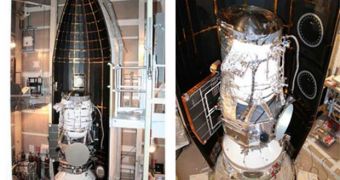The launch of NASA's new space telescope, the Wide-field Infrared Survey Explorer (WISE), is scheduled to take place tomorrow, but weather officials at the Vandenberg Air Force Base, in California, are still unsure whether the state of the weather will allow for the procedures to go on or not. The take-off is highly anticipated, as the new instrument is considered to be many times better than any of its predecessors, and one of the most advanced infrared observatories out there today.
The blast-off is currently scheduled for Friday, November 11, between 9:09 and 9:23 am EST (1409 and 1423 GMT). WISE will be carried to the Earth's orbit atop a Delta II delivery system, which has been extensively used for this type of missions over the years. But, unfortunately, developments in the state of the weather at the VAFB have made officials give an 80-percent chance that the launch will have to be postponed. Thick storm clouds have gathered over the launch facility, and are expected to do the same tomorrow as well, Space reports.
“We've got some challenging weather ahead of us,” the mission's Launch Director, Chuck Dovale, said yesterday in a briefing. “The weather finally starts to clear and break up for Monday and into Tuesday,” Captain Andrew Frey, Jr., who is the NASA weather officer at the base, added. The space agency only has two options in launching the new space vehicle – either try to get it airborne and space-bound on Friday or Saturday, or wait for a launch window next week. The cooling system aboard WISE needs two days to cool off after the failed launch attempts, so we could be looking at a Monday or Tuesday launch, officials say.
“I can report that the instrument and the satellite is ready to go, the flight team is ready to go, and that the operations team is ready to launch and operate WISE. We're really excited about this. It's a matter of just the weather now,” WISE Project Manager Bill Irace says. “We expect to learn new information about how stars form within the Milky Way and the history of star formation. We know that many stars have planets. Follow-up observations with large telescopes like the future James Webb Space Telescope could well find large planets around the brown dwarfs discovered by WISE,” Edward L. Wright says.
He is the principal investigator of the mission, and also the David Saxon Presidential Chair in Physics, and a professor of physics and astronomy at the University of California in Los Angeles (UCLA). “WISE will survey a large part of the universe that has never been surveyed before. I expect that what we find will be amazing. There is still so much we don't know. The most exciting discovery probably will be something we don't even realize is out there,” he says.
The mission was competitively selected under NASA's Explorers Program, managed by the Goddard Space Flight Center in Greenbelt, Maryland. Wright was part of the team that first proposed the telescope, in 1998, and personally oversaw its construction and budget. Science operations and data processing will take place at the Infrared Processing and Analysis Center, which is based at the California Institute of Technology (Caltech), in Pasadena. JPL is also located at and managed by Caltech.

 14 DAY TRIAL //
14 DAY TRIAL //